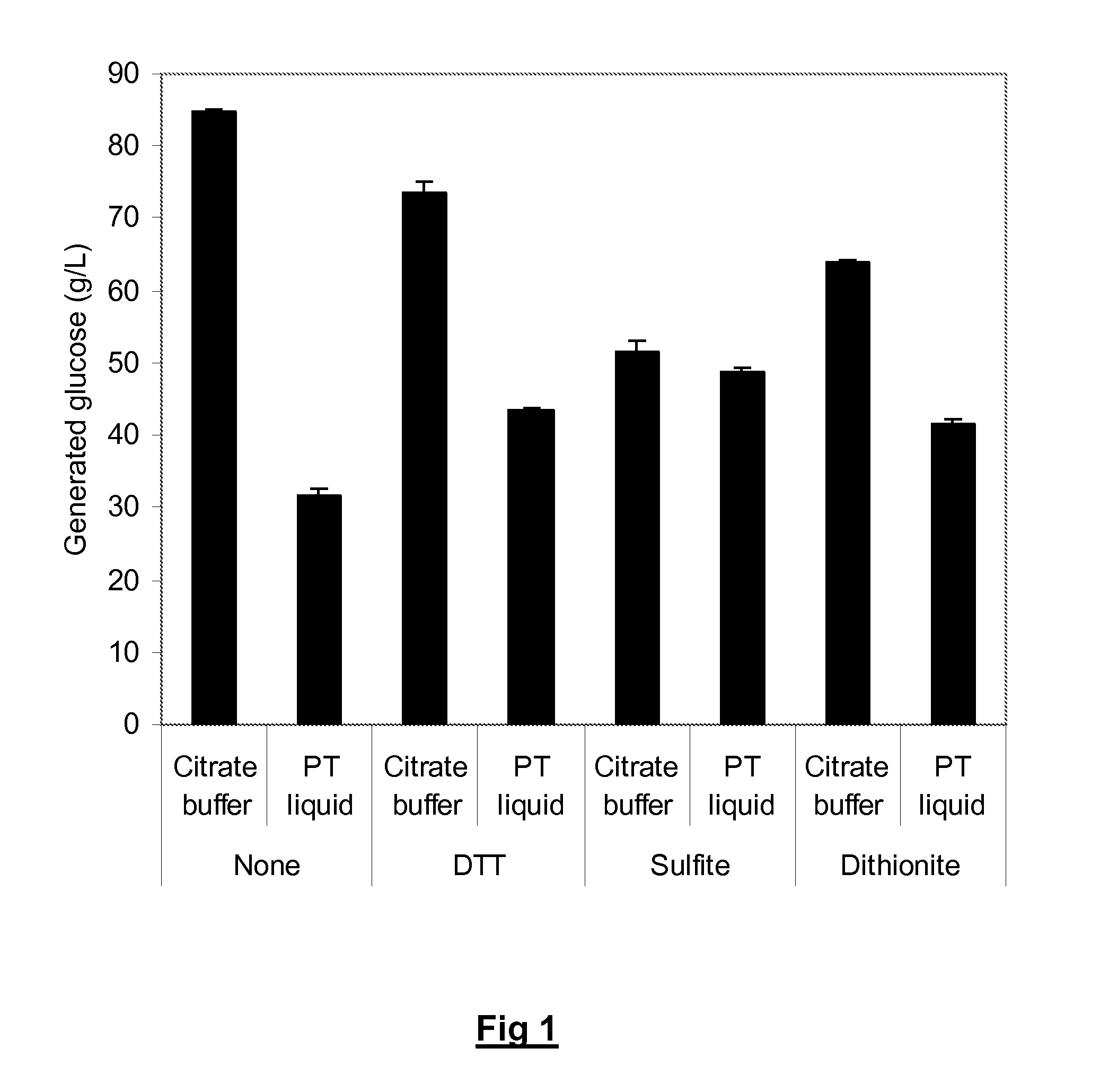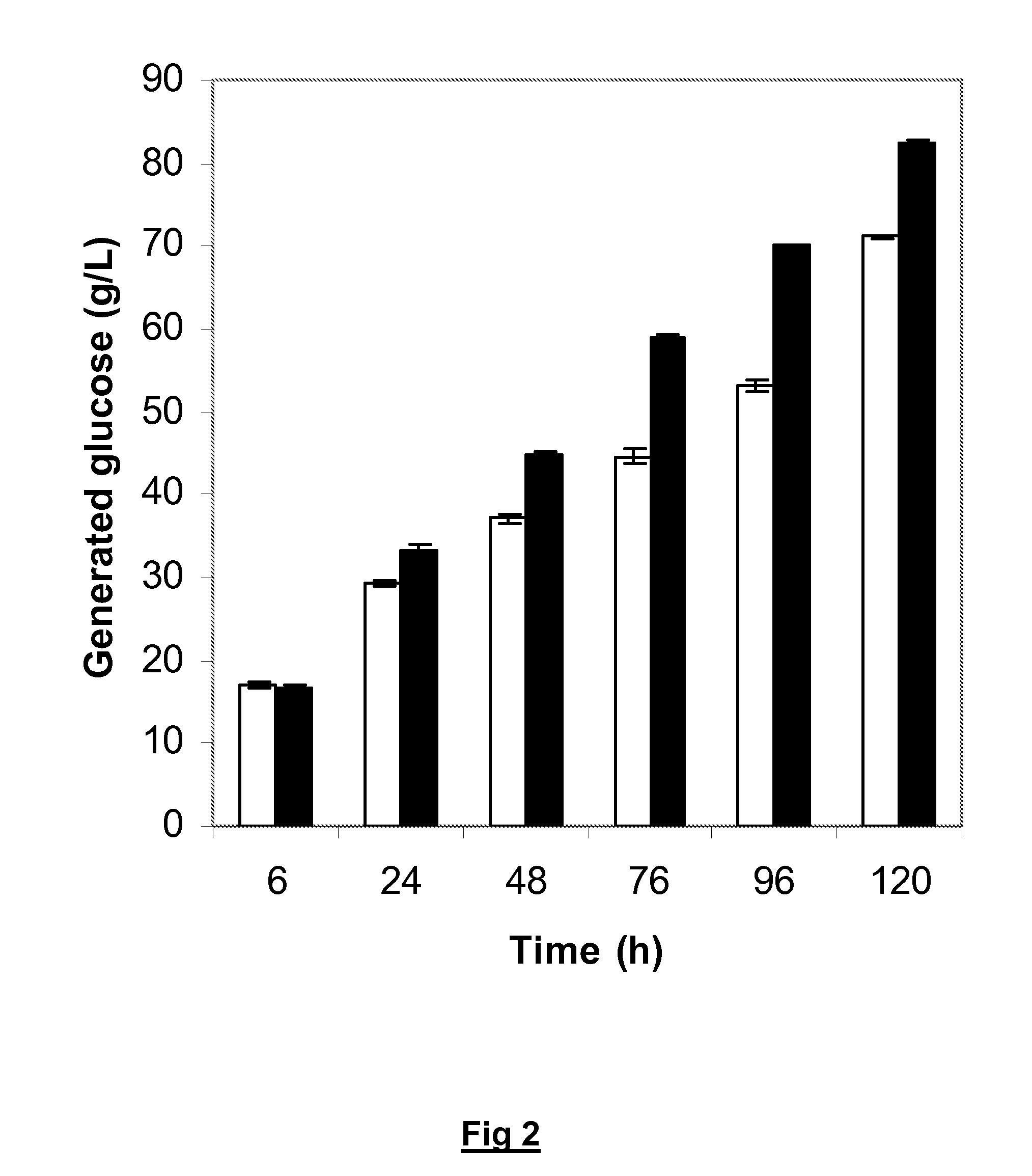Enzymatic hydrolysis of lignocellulosic material in the presence of sulfite, dithionite and/or dithiothreitol
a technology of lignocellulosic material and enzymatic hydrolysis, which is applied in the direction of biofuels, fermentation, microbiology processes, etc., can solve the problems of affecting the economic benefits of adding surfactants to reaction mixtures intended for the production of yield-sensitive low-value-added products such as liquid biofuels, and the cost of enzymes is considered one of the main obstacles, so as to improve the process efficiency
- Summary
- Abstract
- Description
- Claims
- Application Information
AI Technical Summary
Benefits of technology
Problems solved by technology
Method used
Image
Examples
example 1
Pretreatment of Lignocellulosic Material from Spruce
[0054]Pretreatment of unbarked wood chips of Norway spruce (Picea abies) was performed by treatment in a continuous mode with sulfur dioxide at a temperature of 203° C. for 5 min in a 30 liters reactor. One kg of sulfur dioxide was used per 40 kg of wood chips. After the pretreatment, the pH of the slurry was 2 and the dry matter content was 16%. The slurry of pretreated material was cooled to room temperature and stored at 4° C. until further use. Before inclusion in reaction mixtures, the pH of the slurry was adjusted to 5.2 using a 5 M solution of NaOH, and the slurry was diluted with water to achieve the desired concentration of cellulosic substrate.
[0055]The liquid fraction of the pretreated spruce, hereafter referred to as the pretreatment liquid, was obtained by filtration. The concentrations of monosaccharides, acetic acid, and furan aldehydes in the pretreatment liquid were: 22.7 g / l mannose, 18.4 g / l glucose, 11.3 g / l xyl...
example 2
Enzymatic Saccharification of Microcrystalline Cellulose
[0057]Hydrolysis experiments were conducted in 100 ml E-flasks, equipped with cotton plugs and containing reaction mixtures with a total mass of 25 g. The mixtures contained a reaction medium, either pretreatment liquid from Example 1 or a 0.05 M citrate buffer solution, pH 5.2; 10% (w / w) microcrystalline cellulose Avicel PH 101 (Fluka, Buchs, Switzerland); and 2% (w / w) enzyme cocktail consisting of equal amounts of Celluclast 1.5 L and Novozyme 188 (both from Sigma-Aldrich, St. Louis, Mo., USA). The stated activities of the enzyme preparations were: Celluclast 1.5 L, 700 endoglucanase units (EGU) / g; Novozyme 188, 250 cellobiase units (CBU) / g. Some mixtures also contained one of the following reducing agents (all of reagent grade): sodium dithionite (Na2S2O4) (Merck, Darmstadt, Germany), sodium sulfite (Na2SO3) (Merck), and dithiothreitol (DTT) (Sigma-Aldrich), which were added to a final concentration of 15 mM.
[0058]The E-flas...
example 3
Enzymatic Saccharification of Pretreated Spruce Slurry
[0063]Hydrolysis experiments were conducted in 100 ml E-flasks, equipped with cotton plugs and containing reaction mixtures with a total mass of 25 g. The mixtures contained a pretreated spruce slurry from Example 1 adjusted to 10% (w / w) solids, pH 5.2; and 0.5, 1, 2 or 4% (w / w) enzyme cocktail consisting of equal amounts of Celluclast 1.5 L and Novozyme 188. The enzymatic hydrolysis was carried out in the presence or absence of 15 mM dithionite.
[0064]The E-flasks were incubated for 120 h at 45° C. in an orbital shaker set at 170 rpm. During the hydrolysis, 100 μl samples were collected after 6, 24, 48, 76, 96, and 120 h. In the beginning and after completion of the hydrolysis (i.e. at 0 and 120 h), 1.5 ml samples were also taken.
[0065]Samples were chilled on ice, and centrifuged at 14 100 g for 5 min. The supernatants were collected and their glucose concentration was analyzed using a glucometer. Analyses of the sugar content of...
PUM
| Property | Measurement | Unit |
|---|---|---|
| temperature | aaaaa | aaaaa |
| temperature | aaaaa | aaaaa |
| temperature | aaaaa | aaaaa |
Abstract
Description
Claims
Application Information
 Login to View More
Login to View More - R&D
- Intellectual Property
- Life Sciences
- Materials
- Tech Scout
- Unparalleled Data Quality
- Higher Quality Content
- 60% Fewer Hallucinations
Browse by: Latest US Patents, China's latest patents, Technical Efficacy Thesaurus, Application Domain, Technology Topic, Popular Technical Reports.
© 2025 PatSnap. All rights reserved.Legal|Privacy policy|Modern Slavery Act Transparency Statement|Sitemap|About US| Contact US: help@patsnap.com


